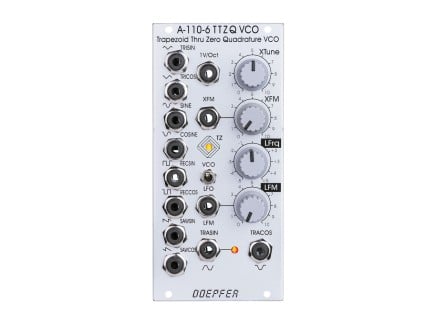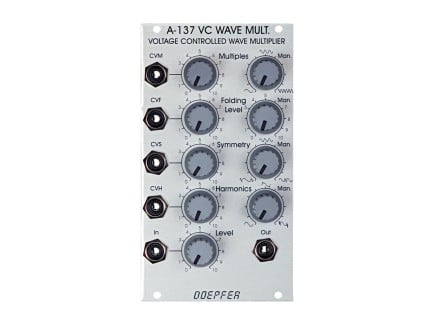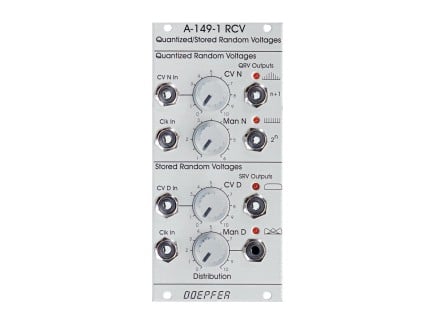
In the world of modular synthesis, Doepfer is an unarguable giant. Doepfer introduced the world to the Eurorack format in the late 1990s, offering a well-defined standard & infrastructure for a new generation of modular synthesizer. He unknowingly opened the floodgates for what would become an explosive industry. In many ways, the bulk of the current modular synthesizer scene's successes are built on the infrastructure that Doepfer developed: manufacturers like Make Noise and Industrial Music Elektronics (FKA The Harvestman) have both expressed that their earliest creations were intended as extensions of Doepfer's A-100 system, not realizing just how popular their own designs might become.
Even at the outset, the Doepfer product line was formidable: dozens of modules that allowed for a wide array of sound design opportunities from traditional subtractive synthesis to much more esoteric, peculiar fare. Enormous systems comprised of clean, starkly-labeled panels heralded back to the day of towering Moog and E-Mu systems and promised younger musicians the first easy, affordable access to the almost mystically alluring world of modular synthesis.
As the world of Eurorack grew, panel graphic became more outrageous, knobs more colorful, and module names more colorful and obscure. We often encounter musicians who look past Doepfer in favor of younger manufacturers, glancing past the the clinical graphics and standardized naming system in favor of flashier avenues—but when they do, they miss out on one of the classiest manufacturers with undoubtedly the widest selection of modules available.
In this ongoing series, we strive to highlight some of the most singular modules that Doepfer offers: the ingenious, the revelatory, and often the outright bizarre designs that keep us coming back to the A-100 Series.
A-110-6 Trapezoid Thru Zero VCO
Eurorack at one point seemed to bring linear thru-zero FM into strong focus, promising rich FM timbres without the pitch drift associated with traditional exponential FM. Doepfer's A-110-4 Quadrature Thru Zero VCO offers this capability with sine waves, but the A-110-6 takes the A-110-4's design several steps further, resulting in a positively singular module with an insane feature set.
The A-110-6 not only sports positively killer exponential and linear thru-zero FM, but also offers a wide array of separate waveshape outputs: triangle, sine, rectangle, saw, and a novel, Synthi-like trapezoid waveshape are all accessible simultaneously—excellent for mixing together complex waveshapes in VCO or LFO modes. Furthermore, an extra output is included for each of these shapes (cosine, "tricosine," "reccosine", etc.), offering matched wave shapes 90 degrees out of phase with the primary outputs. This makes it possible for the A-110-6 to create circular panning when combined with a quadraphonic panner like the Antimatter V3KT or Intellijel Planar 2, as well as a host of other cascaded modulations.
Ten simultaneous distinct waveshape outputs, exponential FM, linear thru-zero FM, and seamless operation in audio and LFO ranges might make this the coolest Doepfer oscillator, if not one of the coolest analog oscillators available altogether.
A-101-3 Modular 12 Stage Vactrol Phaser
With the saturation of swooshy psychedelic guitar sounds and cheap stompboxes in the world, it is not always easy to get excited about phasers—but the A-101-3 is absolutely an exception to this rule. The A-101-3 is a dual six-stage phaser with an absolute ton of features that we have never seen in any other phaser design, making for filtering and modulation effects completely their own.
Each side of the A-101-3 offers access to all of its six stages: direct input and output jacks are available for every stage. And while the module sounds great without utilizing these jacks at all, they offer a wealth of opportunity for experimentation with unique feedback routings. Each side also sports a dedicated attenuverter (polarizer) normalized between the final stage's output and the first stage's input, providing one continuous control for shifting seamlessly between positive and negative feedback for the entire side as a whole.
Each side also offers a dedicated input level control, wet/dry mix control, CV control for phase shift, and a dedicated "Shifted Audio In" that defeats the default Wet signal routing. The A-101-3 is described in Doepfer's documentation more or less as a lab for constructing novel filter types: in fact, it is possible to patch it to produce traditional lowpass or highpass sounds...but it is equally possible to breach into self-oscillating, no-input mixer-style sonic chaos. Two identical sides make it a pleasure to use in stereo, and oh—did we mention that this thing uses twelve vactrols in its audio path?
A-137 Voltage Controlled Wave Multiplier I
It seems in the past few years that a general Buchla and Serge fascination has run rampant through the Eurorack world, and for good reason—many of the sonic techniques in these "West Coast" ecosystems were completely unavailable elsewhere until Eurorack makers began to explore them. The wavefolder is one such beast. First popularized in modules such as the Buchla 208, Buchla 259, and the Serge Wave Multipliers (often referred to as the VCM), wavefolders provide a striking sound much like the opposite of a lowpass filter: by inserting simple sources like sines or triangle waves, the user may acquire an output with rich variable harmonic content.
The Doepfer A-137 seems to be a direct descendant of the concepts in the Buchla 259 and Serge VCM, with even more control than offered in either of these forerunners. Like many wavefolders, the A-137 provides controls for wavefold amount (labelled "multiples" here) and bias (often referred to as "symmetry"), but provides additional controls for input level, wavefolding threshold ("folding level"), and output waveshape smoothness ("harmonics," controlled by an additional VCA for each folding stage). All of these options result in what may be the most highly configurable Eurorack wavefolder module, and the sound itself is the proof: the A-137 does everything from subtle Music Easel-like coloration to Serge growls and completely unheard, harmonically rich modulations.
The A-137 provides a broad range of sounds and requires a bit of finesse to find just the right one: but once you get there, it has an unmistakably deep, rich sound. Another quick tip: try combining this module with a mixer or crossfader at its input to introduce feedback into the signal path. Smooth cascading modulations, grinding distortion, and terrifying howls will emerge with careful tuning.
A-138e Quad 3-Way Crossfader / Mixer / Polarizer
The A-138e appears deceptively simple, but finds use in far more situations than one might anticipate. The A-138e is a quad crossfader with a ton of tricks up its sleeve.
Whereas most crossfaders allow for continuous fading between two sources, the A-138e features 3-way crossfaders, meaning that each channel can be used to create continuous fades between three signal sources for complex morphing between parts of a patch. Equally suited for audio and CV, the A-138e can easily become a hub for signal distribution, audio mixing, and control voltage mangling.
Each channel offers a dedicated patchable inverter on input A, whose output is normalized to input C for easy polarization potential not unlike the typical attenuverter. The B channel has a switch which normalizes it to ground, guaranteeing silence at the center position. Tons of potential emerges: it can be used as an attenuverter, mixer, complex crossfader, and more, making it ideal for effect routing, feedback patches, and all sorts of signal mixing and mingling.
A-149-1 Quantized / Stored Random Voltages
Doepfer's A-149-1 is yet another A-100 module inspired by the Buchla legacy: this time, by the iconic 266 Source of Uncertainty. The Source of Uncertainty is famous for its semi-controllable nature, generating random voltages that are easy to wrangle in into more-or-less predictable ranges under manual or voltage control. It is comprised of two sections: Quantized Random Voltages and Stored Random Voltages.
The Quantized Random Voltage section provides stepped random voltages when presented with a gate at the clock input, in some ways not unlike the traditional noise–>S&H setup. Where it differs from this "classic random" patch is that it provides the user the option to constrain the number of choices of output voltage possible. By using the Manual N control and CV N input, the user can determine the behavior of the N+1 and 2^N outputs, with the N factor variable between 1 and 6. This means that the N+1 output at minimum setting will choose randomly between only two output voltages, and at maximum will choose randomly between only seven distinct output voltages; likewise, the 2^N output produces 2 distinct voltages at minimum, 64 distinct voltages at maximum. This opens a world of opportunities not conceivable in the typical S&H patch, where a theoretically infinite voltage resolution is possible—specific "random" pitches begin to make themselves apparent, specific rhythmic sets begin to emerge, and more: as it turns out, this type of randomness is, for lack of better words, musical. It is like a typical random source—but far more controllable.
 A closer look at the A-149-1
A closer look at the A-149-1
The Stored Random Voltage section provides similar control over the predictability of its output, just through different means. Whereas the Quantized section offers control of the distinct number of output voltage options, the Stored section provides continuous control over probability Distribution: when the D control is set to maximum, output voltages will tend to be fairly high; when set to minimum, they tend to be fairly low. Manual and CV control over the D parameter makes it possible to create randomness that shifts gradually from low to high or vice versa, providing dynamic randomness difficult to achieve through other means.
Oh, and as a bonus, the Stored section also features a dedicated even distribution output: making it possible to use this module to produce four distinct, simultaneous stepped random voltages. Try pairing it with the A-149-2 Digital Random Voltages Expander to create eight random gates as well!

Doepfer too often gets a bad wrap for producing "vanilla" modules, but once one looks past the basic oscillators and lowpass filters, an enormous array of completely out-there, wild modules emerges. Keep your eyes open for our next installment of this series—there are plenty more crazy Doepfer designs to unearth.










